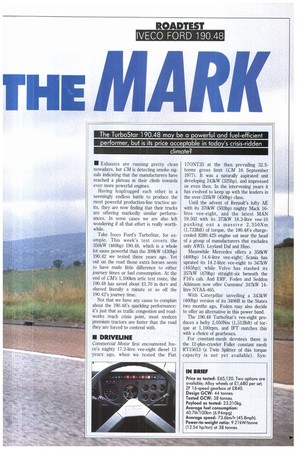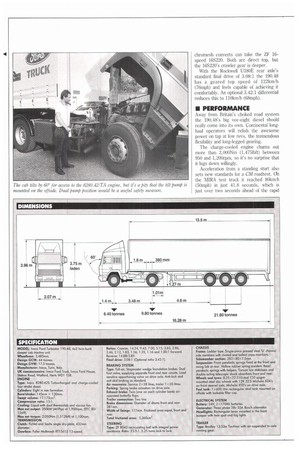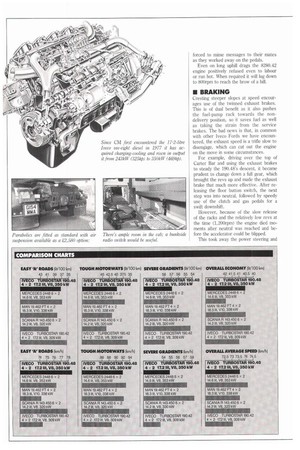Si Exhausts are running pretty clean nowadays, but CM is
Page 31

Page 32

Page 33

Page 34

Page 35

If you've noticed an error in this article please click here to report it so we can fix it.
detecting smoke signals indicating that the manufacturers have reached a plateau in their climb towards ever more powerful engines.
Having leapfrogged each other in a seemingly endless battle to produce the most powerful production-line tractive units, they are now finding that their trucks are offering markedly similar performances. In some cases we are also left wondering if all that effort is really worthwhile.
Take Iveco Ford's TurboStar, for example. This week's test covers the 350kW (469hp) 190.48, which is a whole lot more powerful than the 309kW (430hp) 190.42 we tested three years ago. Yet out on the road those extra horses seem to have made little difference to either journey times or fuel consumption. At the end of CM'S 1,100km artic test route, the 190.48 has saved about £1.70 in dery and shaved literally a minute or so off the 190.42's journey time.
Not that we have any cause to complain about the 190.48's sparkling performance: it's just that as traffic congestion and roadworks reach crisis point, most modern premium tractors are faster than the road they are forced to contend with.
• DRIVELINE Commercial Motor first encountered Iveco's mighty 17.2-litre vee-eight diesel 13 years ago, when we tested the Fiat
170NT35 at the then prevailing 32.5tonne gross limit (CM 16 September 1977). It was a naturally aspirated unit developing 243kW (325hp), and impressed us even then. In the intervening years it has evolved to keep up with the leaders in the over-335kW (450hp) class.
Until the advent of Renault's lofty AE with its 370kW (503hp) mighty Mack 16litre vee-eight, and the latest MAN 19.502 with its 373kW 18.3-litre vee-10 pushing out a massive 2,35 ONm (1,7331bft) of torque, the 190.48's chargecooled 8280.42S engine sat near the head of a group of manufacturers that excludes only AWD, Leyland Daf and Hino.
Meanwhile Mercedes offers a 358kW (480hp) 14.6-litre vee-eight; Scania has uprated its 14.2-litre .vee-eight to 347kW (465hp); while Volvo has stashed its 357kW (479hp) straight-six beneath the F16's cab. And ERF, Foden and Seddon Atkinson now offer Cummins' 347kW 14litre NTAA-465.
With Caterpillar unveiling a 343kW (460hp) version of its 3406B in the States two months ago, Foden may also decide to offer an alternative in this power band.
The 190.48 TurboStar's vee-eight produces a hefty 2,050Nm (1,512Ibft) of torque at 1,100rpm, and IFT matches this with a choice of gearboxes.
For constant-mesh devotees there is the 12-plus-crawler Fuller constant mesh RT15613 (a Twin Splitter of this torque capacity is not yet available). Syn chromesh converts can take the ZF 16speed 168220. Both are direct top, but the 165220's crawler gear is deeper.
With the Rockwell U180E rear axle's standard final drive of 3.08:1 the 190.48 has a geared top speed of 122km/h (76mph) and feels capable of achieving it comfortably. An optional 3.42:1 differential reduces this to 110km/h (68mph).
• PERFORMANCE
Away from Britain's choked road system the 190.48's big vee-eight diesel should really come into its own. Continental longhaul operators will relish the awesome power on tap at low revs, the tremendous flexibility and long-legged gearing.
The charge-cooled engine churns out more than 2,000Nm (1,4751b1t) between 950 and 1,200rpm, so it's no surprise that it lugs down willingly.
Acceleration from a standing start also sets new standards for a CM roadtest.
the MIRA test track it reached 80krivh (50mph) in just 41.8 seconds, which is just over two seconds ahead of the rapid
Mercedes 2448 (43.7 seconds). Nothing else we have driven is in the same class, and the 190.42 TurboStar is more than 25% slower.
Once rolling the 190.48 loses its advantage, however. From 48-80km/h (3050mph) and 64-96km/h (40-60mph) both the Mercedes and MAN's 19.462 are a shade faster, but probably due to their overall gearing.
As mentioned, the actual fuel consumption of the 190.48 and 190.42 over our gruelling three-day test was almost identical: but Iveco Ford's R&D team have reduced the specific fuel consumption of the 19.48's 8280.42 engine to 202g/kWh, which is 5% better than that of the 190.42's 8280.22ST.
That development work has to be paid for, of course, and the 190.48's list price of .265,120 is 1:7,430 above that of the 190.42. Even at current inflated fuel prices that would buy getting on for 17,700 litres (3,900gal) of diesel, which equates to more than 43,550km (27,000 miles). Operators will have to do their own sums before deciding to plump for the lower fuel consumption or the lower purchase price.
But the 19.48's performance is much more than paper facts and figures. All that power peaks at just 1,900rpm. When cruising at the 80km/h (50mph) dualcarriageway limit, the engine is turning over at a lazy 1,250rpm, and on the gruelling M6 section over Shap it was in its element. When baulked, as we were at one point, there was power in reserve to overtake quickly and safely before dropping back into top gear and holding a steady 80km/h (50mph) for the rest of the ascent.
The TurboStar's lazy, powerful gait is far removed from the old oilers with blanketed engines, when drivers were forced to mime messages to their mates as they worked away on the pedals.
Even on long uphill drags the 8280.42 engine positively refused even to labour or run hot. When required it will lug down to 800rpm to reach the brow of a hill.
• BRAKING
Cresting steeper slopes at speed encourages use of the twinned exhaust brakes. This is of dual benefit as it also pushes the fuel-pump rack towards the nondelivery position, so it saves fuel as well as taking the strain from the service brakes. The bad news is that, in common with other lveco Fords we have encountered, the exhaust speed is a trifle slow to disengage, which can cut out the engine on the move in some circumstances.
For example, driving over the top of Carter Bar and using the exhaust brakes to steady the 190.48's descent, it became prudent to change down a full gear, which brought the revs up and made the exhaust brake that much more effective. After releasing the floor button switch, the next step was into neutral, followed by speedy use of the clutch and gas pedals for a swift downshift.
However, because of the slow release of the racks and the relatively low revs at the time (1,200rpm) the engine died moments after neutral was reached and before the accelerator could be blipped.
This took away the power steering and but for the quick thinking by Iveco Ford's demo driver, might have been disastrous.
This was not the first time it had happened during this test, and certainly not the first in a CM test of an Iveco tractive unit; we had the same problem with the 190.42 TurboStar (CM 6 August 1987) and with the 190.36 TurboStar (CM 5 May 1988). Iveco Ford says it is aware of the problem and is looking into it.
Fortunately the service brakes are in a different league. They may give a hint of lethargy, but this is due mainly to the working of the anti-lock system which is standard on the higher powered TurboStar model.
On full brake application at 641anth, (40mph), the combination pulls up within 39m (129ft). This may seem rather long but there was a considerable imbalance across our test trailer axles, particularly down the right-hand side.
On the road the brakes of the outfit behaved impeccably particularly on long descents where prolonged application can often lead to fade. There was no uncertainty about the park brake either, which felt good and firm when holding us steady on the 20% (1:5) test hill.
• HANDLING
The cab's widespread mounting arrangement is a five-point system of anti-roll bars, helical springs and shock absorbers which combine with the chassis' parabolics to take care of most of the road shocks and keep any pitching to a minimum.
Negotiating sharp bends at speed emphasises cab roll at the front corners, but this can be minimised with good driving techniques.
II CAB COMFORT
The amply proportioned cab dates back to the mid-eighties and while not actually supplied with a kitchen sink, it does offer full air conditioning. In addition, the standard 190.48 comes with a 7.6kW Webasto heater which is programmable to warm the engine coolant up to 50°C, and then warm the cab to a pre-set temperature.
There is a wide easy entry to the latest Isringhausen fully adjustable air-suspended seats. From the commanding driving position, there are wide views to the front and sides, supplemented by a triple set of nearside mirrors as well as the right-hand mirror. Both main mirrors are adjustable via a control unit on the fascia.
Louvred side panels behind the B-post allow long glances down the side. Gauges are neatly arranged, but the long strip of warning lights on the central fascia can be as confusing as they are informative. Less important switches are angled away to the left, but all are easy to reach.
It is obvious that the 190.48 is designed for Continental work the cab tilt pump is mounted on the offside. Considering the high retail price, a dual arrangement would be a thoughtful gesture.
• SUMMARY
Tractor unit sales over 29 tonnes are in the doldrums at present with year-to-date figures some 38% down to 7,599 units.
But [FT has no reason to be discouraged it has sold more than 30,000 of the lower-powered 268 and 390kW (359423hp) TurboStars and the more powerful 190.48 will no doubt find favour too.
Powerful, fuel-efficient performer that it is, however, the 190.48 is expensive when compared with other high powered tractors, and in today's crisis-ridden climate if a haulier can find a viay not to spend his money he will.
Iveco Ford has been extremely tardy in dealing with the fuel rack delay/exhaust brake problem, but that apart, the TurboStar's big vee is hard to fault. Designed for 44-tonne operation, it has an impressive power-to-weight ratio at 38 tonnes. Its output at lower engine speeds is equally impressive and its tremendous flexibility and fast gearing will be of immense value when crossing central Europe in time to meet ferry deadlines. Its sheer pulling power makes mincemeat out of hilly regions. In fact with most Continental speed limits being slower than our own, there could be a case for top-speed governors.
At 8,130kg ready-to-roll, the 190.48 is among the heavier 4 X 2s and its 265,120 price tag will not endear it to an ownerdriver's financial adviser. Nonetheless it is easy to drive with a superbly matched driveline, and for driver comforts it is up with the class leaders.
0 by Bryan Jarvis
































































































